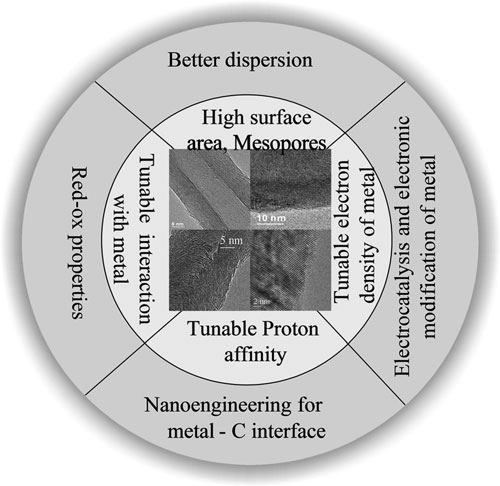| Feb 13, 2013 |
The role of carbon nanomaterials in catalysis
|
|
(Nanowerk News) A new review ("Carbon Nanomaterials in Catalysis: Proton Affinity, Chemical and Electronic Properties, and their Catalytic Consequences") looks at the effects of the orientation of a graphene sheet, the edge structure of carbon nanofibers (CNF), and different surface functional groups on proton affinity, interactions with metal nanoparticles, and electronic modification of these structures, together with their catalytic consequences.
|
|
The ratio of prismatic to basal sites on the edge of carbon nanofibers has a remarkable influence on the properties of both the CNFs and the metal nanoparticles that are supported on it.
|
|
The proton affinity, interactions with metal particles, and electronic density of metal particles can be further manipulated by fine-tuning the functional groups, such as oxygen groups, and by B/N-doping of the CNFs.
|
|
The possibilities of using carbon nanofibers with different graphite-sheet orientations as a platform for rational catalyst design are discussed.
|
 |
| Schematic representation of the principles for rational catalyst design by using CNFs as a platform. (© Wiley-VCH Verlag)
|
|
The review focuses on the recent progress in the theoretical and experimental efforts to obtain a deeper understanding of the effects of carbon nanostructure and surface functional groups on proton affinity, metal/CNF interactions, and electronic properties, as well as their catalytic consequences.
|
|
The authors demonstrate that graphene sheets can be used as basic building blocks to tune the structure of carbon nanofibers and, thus, the properties of metal particles and their catalytic performance.
|
|
They also identify that the ratio of prismatic and basal sites is the most important parameter to manipulate the
surface charge on these carbon nanomaterials and their bonding strength with metal particles.
|
|
This Review provides a useful platform for engineering the redox and electronic properties of metal nanoparticles to manipulate the activity and selectivity of the catalyst.
|

